Location, location, location: Building real estate for cavity dwellers
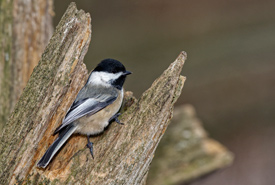
Black-capped chickadee (Photo by Lorne)
The number of tree cavities are often limited on the landscape, but there are many different species that require cavities for their home (such as squirrels, bats and birds). As a result, cavities that suit the needs of a given species are a hot commodity, and competition for them can be fierce.
The reason for this competition is that most species that use tree cavities do not excavate the cavities themselves and instead rely on woodpeckers to do the job. Of course, woodpeckers are excavating cavities for their own use, not out of the goodness of their heart for use by their woodland friends. So, other animals must wait until the woodpeckers are finished using the cavities before they move in.
Reducing competition for nest cavities is a main reason for installing a nest box (the fancy science term for a bird house). Nest boxes are often tailored to suit the needs of a specific bird species, and so the design and placement of the nest box will often determine which species takes up residence.
In March and April of 2018, I made and put up four nest tubes (nest box in a tube shape) for black-capped chickadees on my family farm northeast of Regina, Saskatchewan. These nest tubes were designed specifically for chickadees. They are made from a 12-inch PVC tube that is capped at both ends and that has an entrance hole a few inches from the top.
As chickadees prefer to do a bit of their own excavation within the cavities they use, I filled all of the nest tubes with wood chips, up to the entrance hole. An instructional video on how to create these nest tubes can be found here.
You may be wondering why I installed the nest tubes so early, as March and April on the Canadian Prairies are often still quite wintery. Well, that is the time that chickadees are scouting for potential nesting locations. The early bird doesn’t just get the worm! They want to secure a prime location well before the nesting season begins, which in southern Saskatchewan is mid- to late-May.
Once all of my nest tubes were installed, I periodically monitored them throughout the summer to see if any chickadees had taken up residence. Below is a breakdown for each of the four nest tubes. All the nest tubes were hung on a trembling aspen tree, located within a larger aspen stand.
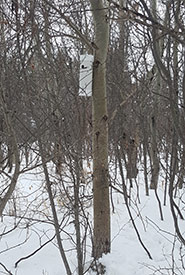
Location of nest tube #1 (Photo by Sarah Ludlow/NCC staff)
Nest tube #1
March 24 – Nest tube installed.
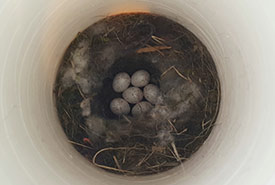
Black-capped chickadee clutch of eggs within nest tube (Photo by Sarah Ludlow/NCC staff)
May 20 – First nest tube check. An adult chickadee flushed from the nest tube, which contained six eggs!
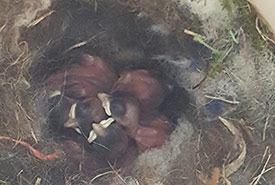
Five chickadee chicks ~1 day old and one unhatched egg (Photo by Sarah Ludlow/NCC staff)
May 31 – Second nest tube check. An adult chickadee flushed from the nest tube and five chicks have hatched.
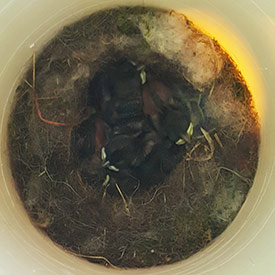
Chickadee chicks starting to grow pin feathers (Photo by Sarah Ludlow/NCC staff)
June 3 – Third nest tube check. One adult alarm calling nearby. Five chicks visible in nest tube.
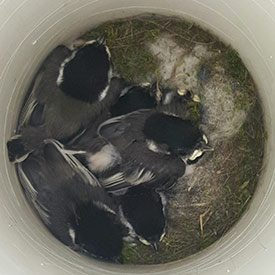
Chickadee chicks in nest tube (Photo by Sarah Ludlow/NCC staff)
June 10 – Fourth nest tube check. One adult alarm calling nearby. Six chicks are visible and beginning to look like little chickadees.
June 16 – Final nest tube check. Nest tube empty because the chicks have fledged. Three chicks were observed in trees near the nest tube, and the adults are bringing them food.
Nest tube #2
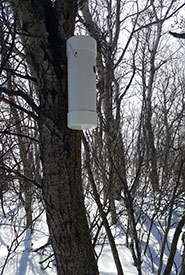
Location of nest tube #2 (Photo by Sarah Ludlow/NCC staff)
April 15 – Nest tube installed.
May 20 – First nest tube check. No bird activity at nest. Wood chips were not excavated by birds, but sticks added to nest tube.
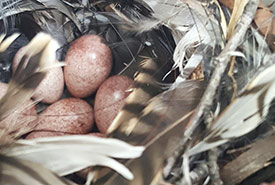
House wren eggs in nest tube (Photo by Sarah Ludlow/NCC staff)
June 16 – Second nest tube check. No adult bird flushed from the nest tube, which contained seven or eight eggs. Eggs identified as house wren eggs.
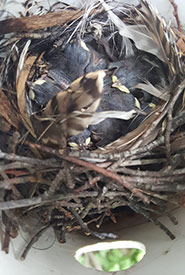
House wren chicks in nest tube (Photo by Sarah Ludlow/NCC staff)
June 24 – Final nest tube check. No adult flushed from the nest tube; however, one was heard singing nearby. Seven chicks have hatched.
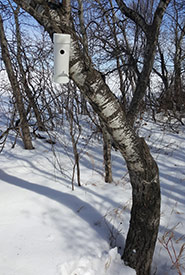
Location of nest tube #3 (Photo by Sarah Ludlow/NCC staff)
Nest tube #3
April 15 – Nest tube installed.
May 20 – First nest tube check. No bird activity observed at nest tube. Sticks added to nest, and wood chips were not excavated by birds.
June 16 – Final nest check. Nest tube full of sticks and feathers. Likely a house wren decoy nest.
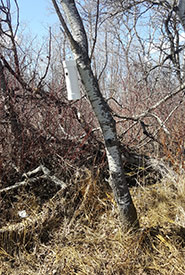
Location of nest tube #4 (Photo by Sarah Ludlow/NCC staff)
Nest tube #4
April 22 – Nest tube installed.
May 20 – First nest tube check. Wood chips were not excavated by birds.
June 16 – Final nest tube check. Nest tube full of twigs. Likely another house wren decoy nest.
In summary, two of my four nest tubes had active nests that likely fledged young — I consider that a pretty good success rate! The other two nest tubes were used as house wren decoy nests, which are nests built as decoys to prevent predators finding the wrens’ actual nest.
If you are interested in building and installing a nest box, check out Nestwatch for nest box plans and tips on placement for the species you are interested in. You can also learn protocols for monitoring nests safely and with minimal disturbance to the birds.


